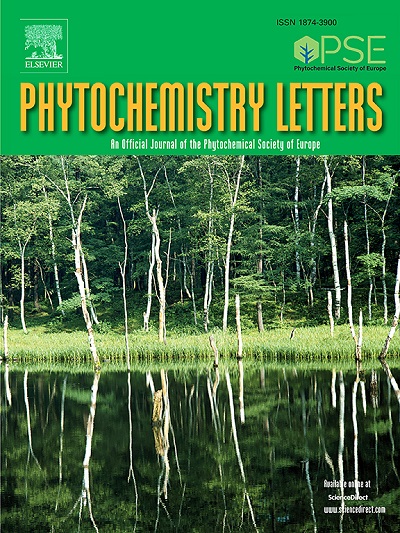Chalcones, flavonoids, and aristolactam alkaloids from Friesodielsia kingii and their biological activities
IF 1.3
4区 生物学
Q4 CHEMISTRY, MEDICINAL
引用次数: 0
Abstract
A new chlorinated-chalcone derivative, friesokinone A (1), and a new 3-flavene, friesokinone B (20), together with 18 known compounds (2–19), were isolated from the twigs and leaves of Friesodielsia kingii (J. Sinclair) Steenis. The dehydration of 5-methoxy-8-formyl-4,7-dihydroxy-6-methylflavan (13) to 20 suggests the possibility that 20 may be an artifact. The structures of the new compounds were elucidated based on spectroscopic data and HRESITOFMS data. In addition, the structures of 1 and 13 were confirmed by single-crystal X-ray diffraction crystallography. Compounds isolated in sufficient quantities underwent evaluation for their nitric oxide (NO) production inhibitory, glucose consumption, and glucose uptake activities. Compounds 2–5 possessed NO production inhibition with IC50 values ranging from 17.3 to 27.6 μM. Notably, compound 2 exhibited the strongest inhibitory effect on NO production. Compound 9 promoted good activities for glucose consumption with an IC50 value of 73.9 μM and glucose uptake with a ratio of 2.0-fold.
来自 Friesodielsia kingii 的查耳酮、类黄酮和马兜铃内酰胺生物碱及其生物活性
从 Friesodielsia kingii (J. Sinclair) Steenis 的枝叶中分离出了一种新的氯化查尔酮衍生物 friesokinone A (1)和一种新的 3-黄酮 friesokinone B (20),以及 18 种已知化合物 (2-19)。5-甲氧基-8-醛基-4,7-二羟基-6-甲基黄烷(13)脱水生成 20,这表明 20 可能是一种伪造品。根据光谱数据和 HRESITOFMS 数据,阐明了新化合物的结构。此外,单晶 X 射线衍射晶体学也证实了 1 和 13 的结构。对分离出的足量化合物进行了一氧化氮(NO)生成抑制、葡萄糖消耗和葡萄糖摄取活性评估。化合物 2-5 具有抑制一氧化氮产生的作用,其 IC50 值在 17.3 至 27.6 μM 之间。值得注意的是,化合物 2 对 NO 生成的抑制作用最强。化合物 9 对葡萄糖消耗具有良好的促进作用,其 IC50 值为 73.9 μM,对葡萄糖摄取的抑制比为 2.0 倍。
本文章由计算机程序翻译,如有差异,请以英文原文为准。
求助全文
约1分钟内获得全文
求助全文
来源期刊

Phytochemistry Letters
生物-生化与分子生物学
CiteScore
3.00
自引率
11.80%
发文量
190
审稿时长
34 days
期刊介绍:
Phytochemistry Letters invites rapid communications on all aspects of natural product research including:
• Structural elucidation of natural products
• Analytical evaluation of herbal medicines
• Clinical efficacy, safety and pharmacovigilance of herbal medicines
• Natural product biosynthesis
• Natural product synthesis and chemical modification
• Natural product metabolism
• Chemical ecology
• Biotechnology
• Bioassay-guided isolation
• Pharmacognosy
• Pharmacology of natural products
• Metabolomics
• Ethnobotany and traditional usage
• Genetics of natural products
Manuscripts that detail the isolation of just one new compound are not substantial enough to be sent out of review and are out of scope. Furthermore, where pharmacology has been performed on one new compound to increase the amount of novel data, the pharmacology must be substantial and/or related to the medicinal use of the producing organism.
 求助内容:
求助内容: 应助结果提醒方式:
应助结果提醒方式:


